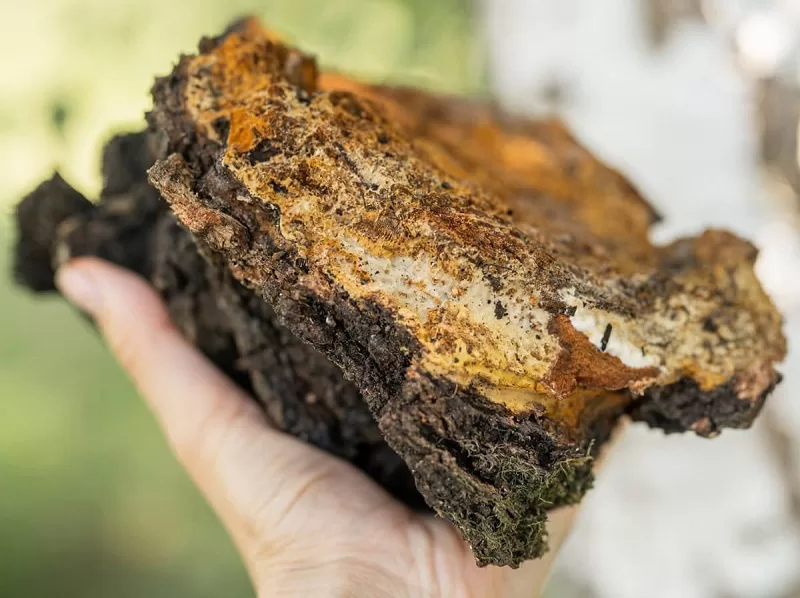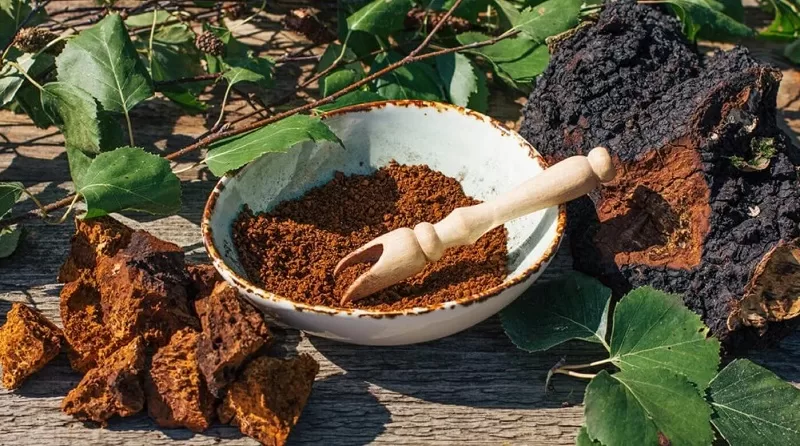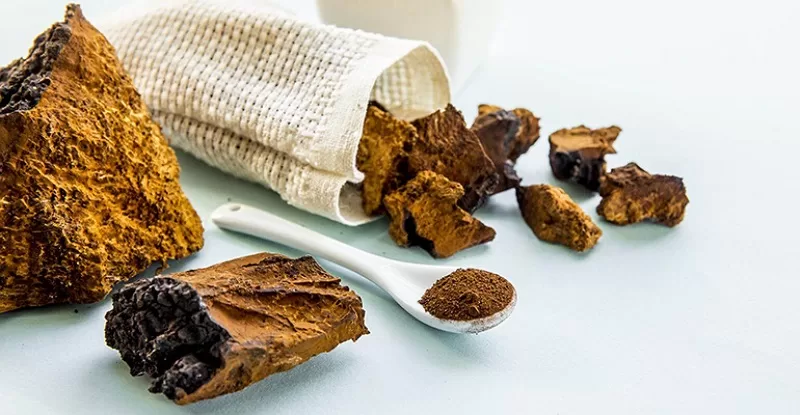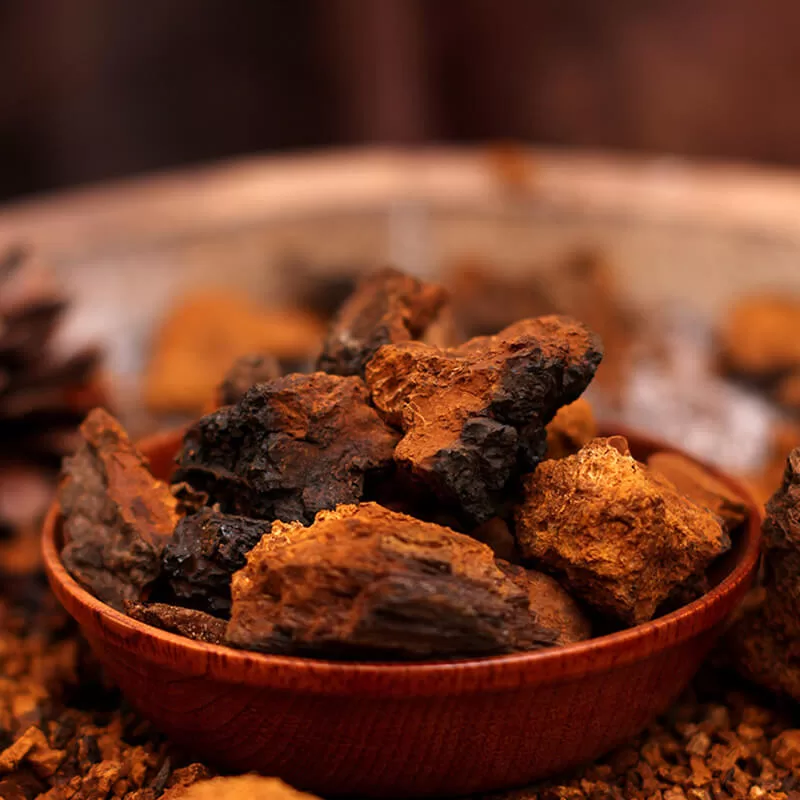Incorporating Chaga Mushroom into Your Daily Diet: Recipes and Tips

For anyone seeking a health boost, the Chaga mushroom is an exceptional addition to daily nutritional intake, packed with antioxidants, and vitamins. With its rich, earthy flavor, this highly nutritious fungus can be a remarkably versatile ingredient in a wide variety of dishes and beverages. In the course of this blog post, we’re taking a journey into the compelling realm of these mushrooms. We’ll unravel their mystery and provide creative, approachable methods to seamlessly integrate this potent healer into your everyday life.
Understanding Chaga Mushroom Benefits
Chaga mushrooms, scientifically known as Inonotus obliquus, are a form of fungus that predominantly grows on birch trees within cold climates, prevalent in regions such as Siberia, Northern Canada, Alaska, and some northern parts of the continental United States. This unique mushroom is recognizable by its hard, charcoal-like exterior and soft, golden interior. Unlike the typical shape we generally connote to fungi, it exhibits an irregular, chunky form that resembles a clump of burnt charcoal more than a typical mushroom.
When it comes to Chaga health benefits, it is a treasure trove. These mushrooms serve as a robust source of nutrition, infused with a broad spectrum of vitamins and minerals. This includes crucial elements like B-complex vitamins, Vitamin D, potassium, cesium, indispensable amino acids, and dietary fibers. Also, this fungi’s profile boasts an array of minerals such as copper, selenium, zinc, iron, manganese, magnesium, and calcium. Additionally, they are abundantly loaded with antioxidants, delivering the crucial function of warding off harmful free radicals within the body, thereby preventing cellular damage and reinforcing overall health.
One of the most notable compounds found in Chaga mushrooms is betulinic acid, derived from the birch trees that they grow on. Betulinic acid, a major component in Chaga, has been the subject of much interest due to its speculated anti-viral and anti-cancer properties. This promising component is under ongoing research for its potential to elevate overall health and combat various ailments. Moreover, they have earned attention for their inherent anti-inflammatory qualities, promoting them as a consumable resource aimed to improve digestive health and fortify the immune system.
Nutritional Value
Chaga are particularly known for their wealth in various beneficial compounds that play an essential role in improving and maintaining overall health. They are an excellent source of antioxidants, even outdoing blueberries in this aspect.
- Triterpenoids: Naturally-present compounds in mushrooms, are reputed for their potential medicinal benefits. These compounds, specifically, hold credit for their anti-viral and anti-cancer attributes;
- Melanins: Chaga is a rich source of melanin, a pigment that promotes skin health and has potential radiation-protective properties;
- Polysaccharides: These are helpful in promoting cardiovascular health, enhancing immune function, and potentially fighting against tumors;
- Polyphenols: Chaga contains a notable amount of polyphenols, known for their antioxidant, anti-inflammatory, and cardio-protective benefits;
- Flavans: These compounds also play a substantial part in their antioxidant properties and have been associated with various health benefits like reducing inflammation, assisting in managing diabetes, and helping in weight management.
Despite its nutrient richness, they are low in calories making them a perfect complement to a healthful diet. The high fiber content supports better digestion, contributes to feelings of fullness, and helps manage weight by promoting healthy bowel movements and gut health.

Sourcing and Selecting High-Quality Chaga
In the quest to incorporate it into your daily diet, sourcing and selecting high-quality ones become pivotal. The general area of growth, the condition of the host tree, and the harvesting process all play crucial roles in determining the quality and potency of the Chaga.
Tips on Sourcing
Chaga mushrooms are typically found growing on birch trees in the cold climates of Northern Hemisphere regions like Siberia, Northern Canada, Alaska, and Northern parts of the United States. When sourcing, opt for those harvested in these regions to ensure they have been exposed to harsh conditions that enhance their nutritional value.
Furthermore, look for Chaga grown in unpolluted areas, far from major cities or industrial zones, to avoid contaminants that can leach into the mushrooms. Also, it’s essential to buy Chaga from reputable suppliers who ethically and sustainably harvest the mushrooms, ensuring they do not damage the host trees and supporting the overall ecosystem’s balance.
Importance of Choosing High-Quality Chaga Mushroom
A high-quality Chaga will have a hard, black exterior, a sign of mature growth, and its main beneficial components – melanin and betulinic acid. Interior, it should have a soft, golden hue, indicating it’s ripe for use.
When buying pre-packaged Chaga, whether as chunks or powder, ensure the package is well-sealed and free from contamination. Steer clear of mushrooms that look moldy or spoilt, as they might lead to health complications.
Lastly, organic Chaga are preferred over non-organic ones. Organic mushrooms are grown without chemical fertilizers or pesticides and, therefore, offer higher nutritional benefits and are free from harmful substances.
Preparing and Consuming Chaga Mushroom
Once you have sourced high-quality Chaga, the next step involves preparing it for consumption. The preparation process is crucial as it affects the end product’s taste and nutritional value.
The Process of Cleaning
Start by brushing off any dirt or debris from the mushrooms using a soft brush. Avoid washing them under running water as they are like sponges and can absorb water, which potentially dilutes their nutrient content. If necessary, you can wipe the mushrooms with a damp cloth.
Drying Techniques
After cleaning, they need to be dried thoroughly before they are ready for consumption. You can slice the mushroom into small thick chunks or thin slices to expedite the drying process. Spread the chunks on a tray and leave them in a dry, well-ventilated area for several weeks.
If you prefer a quicker method, you can use an oven or a dehydrator. Set the temperature below 50 degrees Celsius (about 122 degrees Fahrenheit) to avoid destroying the nutrients. The drying process may take 4 to 48 hours, depending on the thickness of the chunks or slices.
Grinding Chaga Mushroom for Different Uses
Once the mushrooms are dried, they are ready to be ground. Grinding increases their surface area and enables you to extract more nutrients. Use a coffee grinder or a high-powered blender to grind the dried Chaga into a fine powder.
The ground Chaga can then be stored in an airtight container in a cool, dark place for several months. This powder can be used to make Chaga tea or incorporated into smoothies, and soups, or used as a seasoning in your culinary creations. When correctly done, the preparation process enhances taste and nutritional profile, making for a better experience when consuming this exceptional superfood.

Popular Ways to Incorporate Chaga into the Diet
There are many ways to harness the Chaga health benefits and incorporate them into your diet. Here are some of the most popular methods:
Preparing Chaga Tea
Tea is an excellent way to enjoy the Chaga tea benefits. To make Chaga mushroom tea, you need one or two teaspoons of ground Chaga. Immense the ground Chaga in boiling water, reduce the heat, and let it simmer for about 40-50 minutes. The brew should be a rich dark color. Allow the tea to cool down to a drinkable temperature and sip it, enjoying the mushroom tea benefits at its finest. Remember, it has a subtle, earthy flavor that can be accentuated with a slice of lemon or a dollop of honey.
Adding Chaga to Smoothies
Its mild flavor blends nicely with fruits and vegetables, creating wholesome, nutritious beverages. Start by blending about 1 cup of unsweetened almond milk, 1 banana, a handful of fresh or frozen berries, and 1 teaspoon of Chaga powder. If you wish, you can also add a tablespoon of honey, agave nectar, or a piece of ginger for an extra zing. Blend the ingredients until smooth, pour in a glass, and it’s ready to serve. This powerful smoothie is a tasty, refreshing, and nutritious way to begin your day.
Mushroom Coffee
If you’re a coffee lover, considering mushroom coffee is a brilliant idea. Mixing chaga powder with ground coffee before brewing can help you create a delectable cup of coffee with all the combined benefits of Chaga.
Creating Chaga Extract or Tincture
Chaga extract, also known as a tincture, is a concentrated form of beneficial compounds. Based on the study, numerous benefits of the extract have been identified. One key finding is the potent anti-inflammatory properties of the extract, which can play a significant role in mitigating inflammation-related conditions. To prepare an extract, immerse the Chaga chunks in alcohol, store it in a clean jar, and let it sit for approximately six weeks. Afterward, strain the solids, and you are left with a potent tincture that can be dosed drop by drop in your beverages.
Incorporating Chaga into Recipes
Chaga can surprisingly be used in a variety of dishes to add an extra dose of nutrition. You can add ground Chaga to your stews, marinades, salads, or baked goods for an extra healthful punch.
- You can make soup by adding Chaga powder to your vegetable or chicken broth, giving the broth an earthy undertone while boosting its nutritional content;
- The powder can also be used in baking dishes like bread and cookies. It blends well with the flavor of chocolate, making it a unique addition to chocolate brownies and cakes;
- Creating an energy ball can be a fast, easy, and nutritious snack for people on the go. Blend together dates, nuts of choice, coconut flakes, cacao nibs, Chaga powder, and honey. Shape them into balls and refrigerate them for a fantastic, health-boosting snack.

Guidelines on Daily Intake and Dosage of Chaga
Though these mushrooms are a natural and generally safe nutritional supplement, it’s essential to adhere to suggested intake levels to avoid any possible side effects. As a general rule of thumb, aim to consume around 3-5 grams of Chaga extract per day. This dosage can be adjusted according to your individual health goals and your body’s response to Chaga.
Chaga Supplement and Recommended Dosages
If you find it challenging to incorporate it into your meals, the Chaga mushroom supplement can be a convenient alternative. It provides an easy, direct way to consume Chaga and is typically available in forms like capsules or tablets. The dosage of these supplements should be taken as recommended by the manufacturer or a health professional. In general, a dose of 1000-2000 mg per day is commonly taken for general wellness benefits, but this may vary based on individual needs and the specific product’s potency.
Keep in mind that, as with any dietary supplement, it’s advisable to consult with a healthcare professional before beginning a new supplement regimen, especially if you have pre-existing health conditions or are currently taking other medications.
Conclusion
Given the myriad health benefits and versatile uses, incorporating these mushrooms into your diet can be a game-changer for your wellness journey. Don’t shy away from experimenting with recipes, and make the most of this superfood. Welcome to the Chaga revolution!
FAQ
- Is it OK to drink Chaga every day?
Yes, it is generally safe to drink Chaga every day. It is a natural substance that can provide numerous health benefits when consumed regularly. However, as with any supplement, the key lies in moderate consumption to avoid any potential side effects. For utmost safety and to ensure it aligns with your individual health status, always seek professional advice from a healthcare provider prior to integrating it into your daily routine.
- What are the specific mushroom benefits for women overall health?
Mushrooms, including Chaga, offer a wide range of health benefits for women. They are packed with essential nutrients like vitamins, minerals, and antioxidants that support overall health. They can help boost the immune system, support hormonal balance, improve digestive health, and contribute to better skin health. Furthermore, the Chaga mushroom has demonstrated potential anti-cancer properties in various studies. This holds promising implications and could be especially advantageous for enhancing women’s health and well-being.
- Can you eat chaga raw?
They can technically be eaten raw, but they are usually consumed in other forms like tea or extract for better absorption by the body. Chaga is very hard and has a bitter taste when raw, so it is often dried and ground into a powder before consumption.
- What is the best time to take Chaga?
Chaga can be consumed at any time of day, but many people choose to consume it in the morning for its energizing benefits. Some individuals may find it beneficial to take Chaga before meals to aid digestion. Ultimately, the best time to take Chaga may depend on individual health goals and lifestyle. It’s recommended to consult with a healthcare professional for personalized advice.
